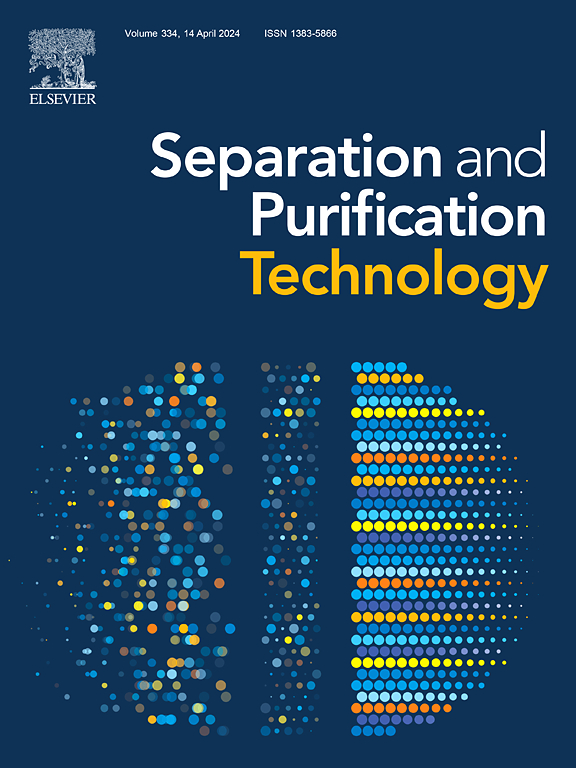mxene基复合材料作为新兴的环境污染物去除吸附剂
IF 8.1
1区 工程技术
Q1 ENGINEERING, CHEMICAL
引用次数: 0
摘要
水污染物的存在对人类健康和水生生态系统都构成重大威胁,因此必须清除这些污染物。在各种去除技术中,吸附是去除水和废水中有害物质的一种有效、可靠的方法,其性能与吸附剂的结构特性密切相关。MXene是一类新的二维(2D)无机材料,由原子薄层组成,主要包括过渡金属碳化物,氮化物或碳氮化合物。MXene具有独特的二维结构、较大的比表面积和丰富的官能团,对各种污染物具有良好的去除效果。本文对mxene基复合材料作为一种新兴的环境污染物吸附材料进行了综述。首先,研究了近年来mxene基复合材料的结构、性能、合成和改性方法等方面的研究进展。此外,还对mxene基复合材料对金属阳离子、放射性核素和有机污染物的吸附性能及其机理进行了系统的综述。我们的研究表明,MXene的层数和表面官能团的数量以及溶液的初始浓度、pH和温度对吸附性能有显著影响。此外,mxene基复合材料(如羟基、氧、氟等)能够通过静电相互作用、离子交换相互作用和表面络合作用与污染物发生强烈的相互作用。这些吸附剂还具有良好的再生能力和回收性能。最后,我们总结了MXene吸附剂面临的挑战,如需要更多地关注MXene材料的高效改性,提高其在实际水体中的性能,考虑其生物相容性,开发新的MXene材料,促进可持续发展等。展望了mxene基材料未来的研究方向。本文综述加深了我们对mxene基复合材料的认识,为其在污染物去除方面的应用奠定了基础。本文章由计算机程序翻译,如有差异,请以英文原文为准。

MXene-based composites as emerging adsorbents for removal of environmental pollutants
The presence of water pollutants poses a significant threat to both human health and aquatic ecosystems, highlighting the necessity of their removal. Among various removal technologies, adsorption is an effective and reliable method for removing harmful substances from water and wastewater, and its performance is closely related to the structural characteristics of the adsorbent. MXene is a new class of two-dimensional (2D) inorganic materials, consisting of atomically thin layers, mainly including transition metal carbides, nitrides, or carbon–nitrogen compounds. With a unique 2D structure, large specific surface area, and abundant functional groups, MXene shows good removal effects on various pollutants. This review focused on MXene-based composites as emerging adsorbents for the removal of environmental pollutants. First, recent research progress on the structure and properties of MXene-based composites, as well as their synthesis and modification methods, was studied. Additionally, the adsorption performance and mechanisms of different pollutants, including metal cations, radionuclides, and organic pollutants onto MXene-based composites, were systematically reviewed. Our research indicates that the number of layers and surface functional groups of MXene, as well as the initial concentration, pH, and temperature of the solution, significantly influence adsorption performance. Additionally, MXene-based composites (e.g., hydroxyl groups, oxygen, fluorine, etc.) are able to strongly interact with pollutants through electrostatic interactions, ion-exchange interactions, and surface complexation. These adsorbents also exhibit good regeneration ability and recycling performance. Finally, we summarized the challenges faced by MXene-based adsorbents, such as the need to focus more on the efficient modification of MXene materials, improving their performance in actual water bodies, considering their biocompatibility, developing new MXene materials, and promoting sustainable development, among others. We also outlined future research directions for MXene-based materials. This review deepens our understanding of MXene-based composite materials and lays the foundation for their application in pollutant removal.
求助全文
通过发布文献求助,成功后即可免费获取论文全文。
去求助
来源期刊

Separation and Purification Technology
工程技术-工程:化工
CiteScore
14.00
自引率
12.80%
发文量
2347
审稿时长
43 days
期刊介绍:
Separation and Purification Technology is a premier journal committed to sharing innovative methods for separation and purification in chemical and environmental engineering, encompassing both homogeneous solutions and heterogeneous mixtures. Our scope includes the separation and/or purification of liquids, vapors, and gases, as well as carbon capture and separation techniques. However, it's important to note that methods solely intended for analytical purposes are not within the scope of the journal. Additionally, disciplines such as soil science, polymer science, and metallurgy fall outside the purview of Separation and Purification Technology. Join us in advancing the field of separation and purification methods for sustainable solutions in chemical and environmental engineering.
 求助内容:
求助内容: 应助结果提醒方式:
应助结果提醒方式:


